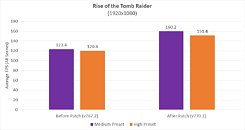Tuesday, June 27th 2017

More Ryzen Gaming Performance Patches: ~28% Gain in ROTR on Medium/High Presets
AMD's Ryzen has been generally well received as a gaming processor, but it has always had a small Achilles Heel in one area; gaming performance. While some may argue the obviously correct statement that it is "good enough" for many situations, it was obviously not up the level of awesome the rest of the architecture seemed to be at.
It would now appear it may simply be a lack of optimization to blame more than an inherent architectural issue. AMD has seen a major performance patch in one game, Rise of the Tomb Raider, that has netted it around 28% higher average FPS in the medium and high presets, which just so happen to be more CPU bound than higher settings. When asked how these performance improvements were attained, developer Crystal Dynamics had the following to say on the matter:
"Rise of the Tomb Raider splits rendering tasks to run on different threads... By tuning the size of those tasks - breaking some up, allowing multi-core CPUs to contribute in more cases, and combining some others, to reduce overheads in the scheduler - the game can more efficiently exploit extra threads on the host CPU."Very nice. The patch should already be auto applied via Steam. If you want to test against the old build, you can always opt in to an older steam beta (such as v767.2 or earlier) to see the old performance vs the new. This can be done easily from the game properties menu, and a nice "how-to" is shown in the source article.
There were also some major performance improvement patches to certain aspects of other applications such as ZBrush, which are obviously less relevant to gamers but very relevant to content creators. More on that is available in the source article from AMD, below.
Source:
AMD
It would now appear it may simply be a lack of optimization to blame more than an inherent architectural issue. AMD has seen a major performance patch in one game, Rise of the Tomb Raider, that has netted it around 28% higher average FPS in the medium and high presets, which just so happen to be more CPU bound than higher settings. When asked how these performance improvements were attained, developer Crystal Dynamics had the following to say on the matter:
"Rise of the Tomb Raider splits rendering tasks to run on different threads... By tuning the size of those tasks - breaking some up, allowing multi-core CPUs to contribute in more cases, and combining some others, to reduce overheads in the scheduler - the game can more efficiently exploit extra threads on the host CPU."Very nice. The patch should already be auto applied via Steam. If you want to test against the old build, you can always opt in to an older steam beta (such as v767.2 or earlier) to see the old performance vs the new. This can be done easily from the game properties menu, and a nice "how-to" is shown in the source article.
There were also some major performance improvement patches to certain aspects of other applications such as ZBrush, which are obviously less relevant to gamers but very relevant to content creators. More on that is available in the source article from AMD, below.

37 Comments on More Ryzen Gaming Performance Patches: ~28% Gain in ROTR on Medium/High Presets
I just don't get why did it take so long for AMD and the general techpress to get a wind of this.
AMD needs to make a better prefetcher for their CPU, until they do, Ryzen is just too slow for high-end gaming.
There are not "car lengths of performance" between the 1800X and 7700K either - it's only ~18% in a game that has always been plagued with performance issues...Cough....Gamesworks...Cough. Let's see what happens when the next Tomb Raider comes out and was built from the ground up to work well with Zen.
Anything with a decent DX12 or Vulkan render that scales properly over multiple cores however is another a story. So for gaming the i5-7600K and the i7-7700K are perfectly viable choices.
I usually use a rig between 3-to-5 years. So for my budget it was a nobrainer to choose an R5 1600 over an i5-7600 (non-K) at the same price point. Got +50% more cores and +200% more threads for the same money, it is a much better "workhorse" and hopefully 1-2 years down the line as gaming engines mature towards using more cores, probably a better choice for gaming as well in the long(er) run. Granted I gave up 10% IPC per core for that, but I simply set my 1600 to a 36x multi with a +0.054V bump on th vcore, so it is happily running at 3.6GHz on all cores at near stock voltages.